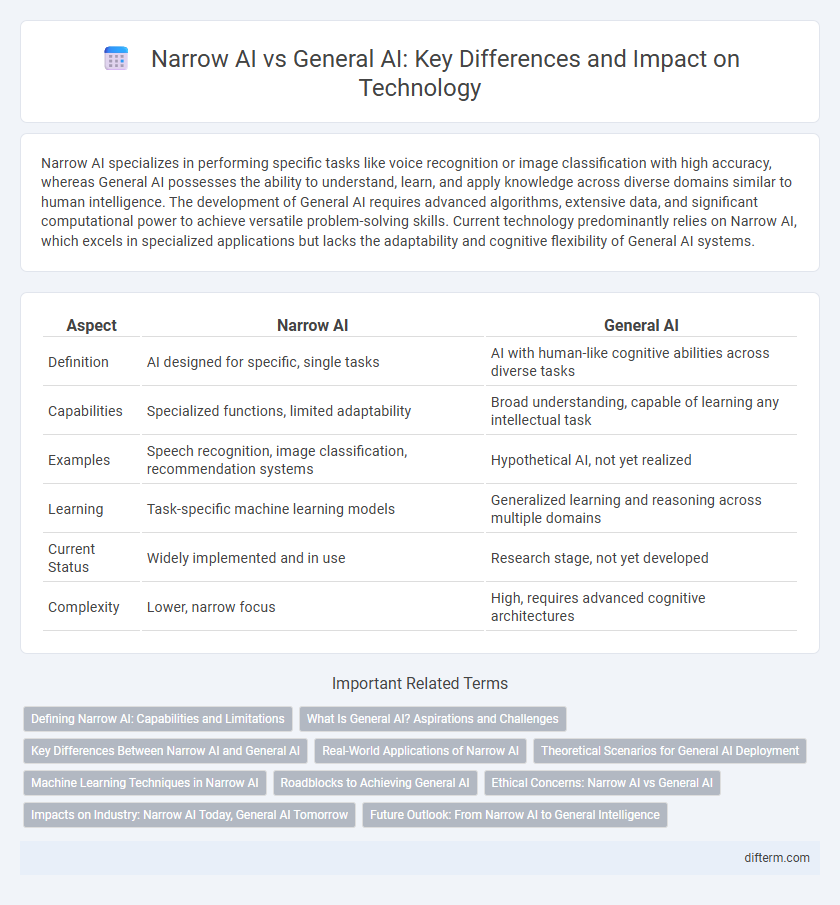Narrow AI specializes in performing specific tasks like voice recognition or image classification with high accuracy, whereas General AI possesses the ability to understand, learn, and apply knowledge across diverse domains similar to human intelligence. The development of General AI requires advanced algorithms, extensive data, and significant computational power to achieve versatile problem-solving skills. Current technology predominantly relies on Narrow AI, which excels in specialized applications but lacks the adaptability and cognitive flexibility of General AI systems.
Table of Comparison
| Aspect | Narrow AI | General AI |
|---|---|---|
| Definition | AI designed for specific, single tasks | AI with human-like cognitive abilities across diverse tasks |
| Capabilities | Specialized functions, limited adaptability | Broad understanding, capable of learning any intellectual task |
| Examples | Speech recognition, image classification, recommendation systems | Hypothetical AI, not yet realized |
| Learning | Task-specific machine learning models | Generalized learning and reasoning across multiple domains |
| Current Status | Widely implemented and in use | Research stage, not yet developed |
| Complexity | Lower, narrow focus | High, requires advanced cognitive architectures |
Defining Narrow AI: Capabilities and Limitations
Narrow AI, also known as weak AI, refers to artificial intelligence systems designed to perform specific tasks such as speech recognition, image classification, or recommendation algorithms with high efficiency. These systems excel in their designated domains but lack the ability to generalize knowledge or perform outside their programmed functions, highlighting a key limitation compared to General AI. Despite advanced capabilities in pattern recognition and data processing, Narrow AI cannot possess true understanding or consciousness, restricting its applications to predefined scenarios.
What Is General AI? Aspirations and Challenges
General AI refers to artificial intelligence systems capable of understanding, learning, and applying knowledge across a wide range of tasks with human-like cognitive abilities. The aspiration is to develop machines that can perform any intellectual task a human can, enabling advanced problem-solving, reasoning, and creativity. Major challenges include achieving true contextual understanding, emotional intelligence, and the ability to generalize knowledge across diverse domains.
Key Differences Between Narrow AI and General AI
Narrow AI is designed to perform specific tasks such as language translation or facial recognition, excelling within predefined parameters and lacking versatility beyond its training data. General AI aims to possess human-like cognitive abilities, enabling it to understand, learn, and apply knowledge across diverse domains with adaptive problem-solving skills. Key differences lie in scope, flexibility, and cognitive capabilities, where Narrow AI operates under limited contexts while General AI demonstrates autonomous reasoning and consciousness-like functions.
Real-World Applications of Narrow AI
Narrow AI powers real-world applications such as virtual assistants, fraud detection systems, and personalized recommendations by performing specific tasks with high efficiency. In industries like healthcare, it enables accurate diagnostic imaging and predictive analytics for patient care. Unlike General AI, Narrow AI excels in targeted functions without human-like consciousness or adaptability.
Theoretical Scenarios for General AI Deployment
Theoretical scenarios for General AI deployment envision highly autonomous systems capable of performing any intellectual task a human can, surpassing Narrow AI's limited, specialized functions. These scenarios include AI-driven scientific research acceleration, fully automated decision-making in complex environments, and adaptive systems transforming industries through continuous learning. Achieving true General AI requires significant advancements in machine learning algorithms, cognitive architectures, and ethical frameworks to ensure safe and beneficial integration.
Machine Learning Techniques in Narrow AI
Narrow AI leverages specialized machine learning techniques such as supervised learning, unsupervised learning, and reinforcement learning to perform specific tasks like image recognition, natural language processing, and recommendation systems. These models are trained on large datasets to identify patterns and make predictions within narrowly defined domains without possessing general intelligence. Unlike General AI, which aims to replicate human cognitive abilities across diverse tasks, Narrow AI remains confined to optimized algorithms designed for singular applications.
Roadblocks to Achieving General AI
Narrow AI excels at specific tasks using predefined algorithms, while General AI aims to replicate human-like cognitive abilities across diverse functions. Major roadblocks to achieving General AI include limitations in machine learning models' adaptability, the challenge of developing common-sense reasoning, and the absence of robust frameworks for understanding context and emotions. Advances in neural architecture, unsupervised learning, and ethical AI frameworks remain critical for overcoming these barriers and realizing true General AI.
Ethical Concerns: Narrow AI vs General AI
Narrow AI operates within specific tasks, raising ethical concerns related to bias, privacy, and decision transparency in areas like facial recognition and credit scoring. General AI, with its advanced autonomy and broader cognitive capabilities, poses deeper ethical risks involving control, accountability, and potential misuse impacting society at large. Ensuring robust ethical frameworks for both Narrow and General AI requires continuous scrutiny of algorithmic fairness, data security, and governance policies.
Impacts on Industry: Narrow AI Today, General AI Tomorrow
Narrow AI drives efficiency and innovation across industries by automating specific tasks such as data analysis, customer service, and predictive maintenance, resulting in increased productivity and cost savings. Industries like healthcare, finance, and manufacturing benefit from Narrow AI's specialized capabilities, enabling faster decision-making and improved accuracy. General AI promises to revolutionize these sectors further by integrating human-like cognitive abilities, fostering advanced problem-solving, and enabling autonomous operations that adapt to complex and unpredictable environments.
Future Outlook: From Narrow AI to General Intelligence
Narrow AI excels at specific tasks with high efficiency, powering technologies such as voice assistants, recommendation systems, and image recognition. The future outlook envisions a transition from these specialized systems to General AI, capable of autonomous reasoning, learning, and problem-solving across diverse domains. Advances in machine learning, neural networks, and cognitive computing drive progress toward achieving human-level intelligence and versatile AI applications.
Narrow AI vs General AI Infographic

 difterm.com
difterm.com